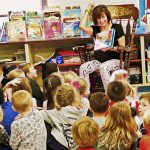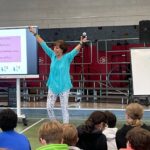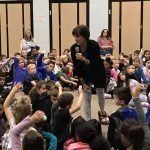LET’S SHARE A STORY TOGETHER!
Suggested audiences: PreK 3 – PreK 4
Program length: 30 minutes
In this interactive, energetic presentation, I talk briefly about my author life and kids get a silly peek at what goes on in my office. As we explore a picture book or two, they are encouraged to think about what they might see, hear, smell, feel, and taste in the storyline. We do fingerplays and songs, clap out a rhythm, chat about rhyme, and I read one of my books. Circle time in a classroom of approximately twenty kids is the preferred set up, but my interactive PowerPoint slides work for larger groups works, too. The teacher and librarian in me knows how to keep the “littles” busy and entertained no matter what! Parents and teachers can follow up with ELA and STEM activities from the FREE guide listed on this site.
LET’S PLAY WITH WORDS!
Suggested audiences: Grades K – 1
Program length: 45 minutes
What was I like as a child and did my childhood influence my writing? What is my day-to-day author life like? Where’s my office? Am I the author or illustrator or both? Why do I think about the parts of a picture book and the five senses when I’m writing? How do writers find the best words to use?
After a short introduction to how and why I became an author, we take a close look at the exciting words found in several picture books. Students interact with rhyming phrases and onomatopoeia, and see how each word is important to a story. We briefly explore an illustrator’s job, and then it’s time for more audience involvement as one picture book is read in its entirety. With songs, movement, and a guessing game, there is never a dull moment!
ROCK THE RHYME AND RHYTHM IN YOUR READING AND WRITING!
Suggested audiences: Grades 2 – 3 
Program length: One hour
What was I like as a child and did my childhood influence my writing? What is my day-to-day author life like? What does my office look like? Am I an author or an author-illustrator? How can a writer include rhyme and rhythm?
This program begins the same as the one above; however, it is longer and goes into more depth. Students learn about the very first book I penned as a child, what inspires me, and what my writing space looks like. With a focus on picture books, we dig into rhyme and rhythm and create couplets on the spot. While interacting with sensory details, descriptive adjectives, active verbs, onomatopoeia, and more, kids discover how each word is important in a story. Volunteers become Super-Duper Fixer-Uppers (editors), and we giggle over the challenges that come with revision. Depending on the reading level of the students or the time of year, we touch on character, plot, and setting, and how these elements in a non-rhyming story contribute to its rhythm.
STEP INTO MY WRITING WORLD, AND YOURS!
Suggested audiences: Grades 4 – 6
Program length: One hour
What was my very first book? What is my process for creating characters, deciding on a setting, and developing a plot? What events have inspired me to take on a new topic? Who helps me revise my work? Why is research important in writing fiction? Where do I find new ideas? What am I working on now?
In this hands-on presentation geared toward a middle-grade audience, I talk about my journey to publication and give everyone an insider’s view of the writing business. From the point of inspiration to the final draft, students discover the process involved in creating picture books and novels, and they’ll gain an understanding of the similarities and differences involved in writing a 200-word story vs. a 35,000-word one. (Excerpts from my work will be read.) They’re put to work as my editors to learn about editing, rewriting, and revision, and how research plays a key part in writing fiction. Students will find out how to create interesting characters, how characters’ actions and dialogue enhance plot, and how great story ideas are everywhere. Lastly, they’ll learn my secret to eliminating writer’s block! Fast and furious writing activities are sprinkled throughout the presentation to help even the most antsy kids stay focused and involved. By the end of an hour everyone understands why it takes hard work, patience, and a sense of humor to be a writer.
